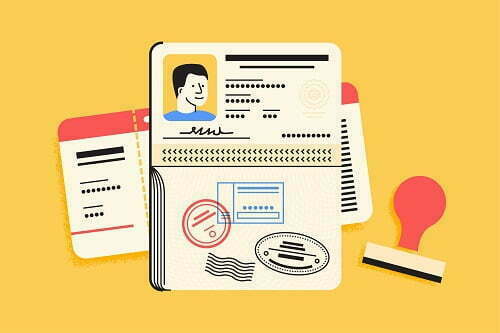Table of Contents
- #1. How many countries can I travel to on a Schengen visa?
- #2. Who issues the Schengen visa?
- #3. Who can apply for the Schengen visa?
- #4. Who needs a Schengen visa?
- #5. I am traveling to three countries in Europe. Do I need different visas?
- #6. Where do I apply to get the Schengen visa?
- #7. For how many days can I stay in a European country with my Schengen visa?
- #8. Are there different kinds of Schengen visas? If yes, which one do I need?
- #9. What is the difference between single entry and multiple entry visas?
- #10. How long does the Schengen visa application process take?
- #11. Do I need to make an appointment to go to an embassy/consulate?
- #12. What questions are commonly asked during the interview for a Schengen visa?
- #13. Is it easy to apply for Schengen visa?
- #14. What documents do I need to submit to apply for a Schengen visa?
- #15. Where can I get the application form for the Schengen visa?
- Key takeaways
A common visa for all EU countries, the Schengen visa is a basic requirement for people who are looking to travel to Europe. This visa allows free travel to the holder within the Schengen zone, depending on the validity and the timeframe. Talking about the Schengen visa, there are certain things that you need to know before you begin your application process.
Therefore, here are some Schengen visa frequently asked questions that can help you learn about Schengen visa application and requirements.
#1. How many countries can I travel to on a Schengen visa?
The Schengen visa allows the visa holder to travel to 26 countries in Europe. Some of these countries include Austria, Belgium, France, Germany, Denmark, Greece, Iceland, Italy, Spain, Portugal, Sweden, Switzerland, Malta, Norway, and Finland.
#2. Who issues the Schengen visa?
The consulates, embassies, and selected service providers of a country belonging to the Schengen state issue a Schengen visa. The visa allows the holder to move freely within the Schengen area for a fixed period, depending on the kind of visa issued.
#3. Who can apply for the Schengen visa?
There is no restriction to who can apply for the Schengen visa. People from all ages, castes, religions, and nationalities can apply.
#4. Who needs a Schengen visa?

All citizens belonging to a non-European country, especially those from Russia, India, China, and Africa, require a Schengen visa to travel to any Schengen country. Other non-European citizens belonging to countries like Australia, the United States, Canada, Mexico, Japan, and Brazil have signed a visa waiver agreement with the EU. Consequently, it permits the citizens to freely travel within the Schengen area without a visa for up to 90 days.
#5. I am traveling to three countries in Europe. Do I need different visas?
If all the three countries are members of the Schengen state, you don’t need to take three separate visas. You can travel between all three countries with one Schengen visa.
#6. Where do I apply to get the Schengen visa?
In case you are traveling to only one Schengen country, you need to apply through the official embassy/consulate of the designated country. However, if you are traveling to more than one country, then the application has to be made from the embassy/consulate of the country where you will spend the maximum days.
#7. For how many days can I stay in a European country with my Schengen visa?
There are some restrictions that vary for different countries, and it also depends on the kind of visa you get. The most common Schengen visa issued to applicants allows for a stay of a maximum of 90 days in every six-month period, i.e., in a year, you will be able to stay in the Schengen countries for a maximum of 180 days.
#8. Are there different kinds of Schengen visas? If yes, which one do I need?

The embassy/consulate will issue a Schengen visa to you depending on the nature and purpose of your travel to the Schengen state.
Generally, there are three kinds of Schengen visas-
- Uniform Schengen Visa- The uniform Schengen visa is the most basic form of visa that allows you to travel freely/transit/reside in the desired member state for 90 days in every six-month period.
- The Limited Territorial Validity Visa- This is a limiting visa that allows you to travel only to the Schengen country that has issued the visa or the certain states that are explicitly specified while applying for this visa.
- The National Visa- The National visa is for individuals who are either studying, residing permanently, or working in any one of the Schengen members’ states.
#9. What is the difference between single entry and multiple entry visas?
This is one of the most common Schengen visa frequently asked questions. The difference between the single entry and the multiple entry visa is straightforward. Holders of the single-entry visa are allowed to enter any Schengen state only for one time. The visa validity expires once they leave the Schengen Area, even if the usual 90 day stay period is not over.
On the other hand, multiple entry visa holders can go in and out of the Schengen area as required. They do not need to keep applying for the visa as long as the 90-day period is still valid.
#10. How long does the Schengen visa application process take?
In general, it does not take more than 24-48 hours to process a Schengen visa. However, there are times when this could take longer, ranging from 14 to 21 days for some countries.
#11. Do I need to make an appointment to go to an embassy/consulate?
This depends on the embassy or consulate that you are applying from. Common practice dictates that all applicants must make an appointment either via a phone call or by emailing the embassy.
#12. What questions are commonly asked during the interview for a Schengen visa?

During the interview, the interviewer can ask basic questions about your time of stay in the Schengen states. Additionally, they also ask some personal questions about your travel details, intended whereabouts, and finances. Make sure to answer these questions with confidence and honesty.
#13. Is it easy to apply for Schengen visa?
Yes, the process of applying for the Schengen visa is simple. As long as you have the desired documentation ready, you just need to visit the embassy, complete your biometrics, and submit your documents and passport.
#14. What documents do I need to submit to apply for a Schengen visa?
The document requirements of the Schengen visa vary from applicant to applicant. Please visit the website and check the exact requirements pertaining to the kind of Schengen visa you are applying for.
Here’s a list of some basic documents that you will need to submit while applying for the visa-
- A completed and signed visa application form.
- Two recent and identical photos.
- A copy of the passport and the original passport with over 3 months of validity beyond the expiry date.
- A cover letter explaining the reason for travel.
- A confirmed return air ticket.
- Proof of accommodation in the Schengen country.
- Proof of funds and means to pay for yourself in the Schengen state.
- A mandatory travel insurance.
#15. Where can I get the application form for the Schengen visa?
You can download the Schengen visa application form from the official Schengen visa website. Irrespective of the country, the visa application form remains the same.
Key takeaways
- If you want to travel or move to a country in Europe, then you will need to apply for a Schengen visa.
- There are three kinds of Schengen visas, and you get one according to your purpose and duration of stay.
- Talking about the Schengen visa – frequently asked questions, people have many doubts about this visa.
- To make the Schengen visa application process easy, you can go through the above-mentioned common questions on the Schengen visa requirements.
We hope we resolved all your doubts through this list of the Schengen visa frequently asked questions. If you are still confused about the visa process, we can help. You just need to reach out to us or drop a comment below!
Liked this blog? Read next: Norwegian visa | 5 Questions you must ask before getting this visa






